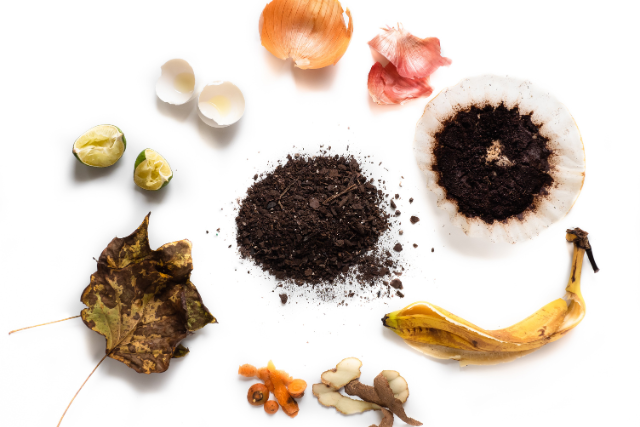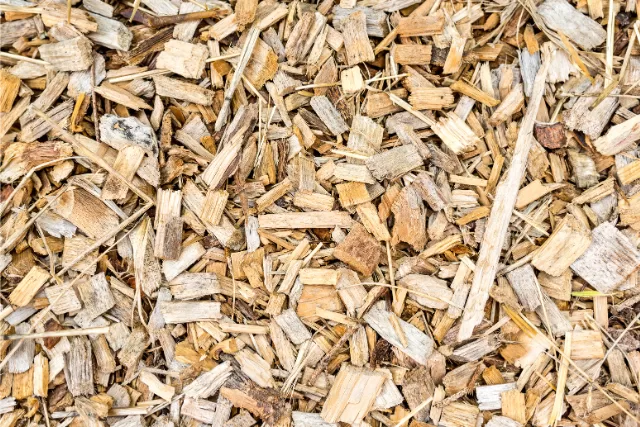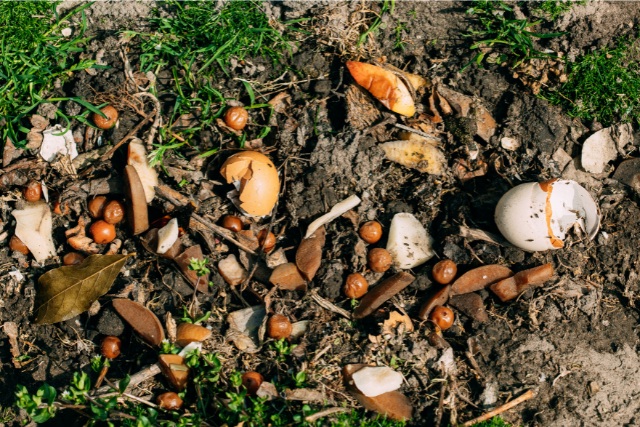Compost is the result of organic materials breaking down into a nutrient-rich, soil-like substance. Think of compost as nature’s way of recycling – turning kitchen scraps, yard waste, and other biodegradable materials into something incredibly valuable for your garden.
Compost is created through a process called decomposition, where microorganisms such as bacteria, fungi, and even worms break down materials like fruit peels, grass clippings, and leaves.
Over time, these organic materials turn into a dark, crumbly substance that is commonly refered to as “black gold” for the garden. This is because compost is packed with nutrients like nitrogen, phosphorus, and potassium that are essential for healthy plant growth.
The Role of Green and Brown Materials
The secret to creating high-quality compost lies in finding the right balance of two types of materials: green materials and brown materials. Green materials are rich in nitrogen and include things like fruit and vegetable scraps, fresh grass clippings, and coffee grounds.
Brown materials, on the other hand, are high in carbon and consist of items like dry leaves, straw, and newspaper. When combined in the right ratio, these materials work together to fuel the decomposition process and create compost that enhances your garden’s soil health.
In the next sections, we’ll check out the essential ingredients of compost and how to balance these materials for maximum effectiveness. But first, let’s take a closer look at why composting is so beneficial for your garden.
The Essential Ingredients of Compost

Creating nutrient-rich compost requires a combination of key ingredients: green materials, brown materials, water, and air. Each of these components plays an important role in the composting process, and getting the balance right is crucial for success.
Green Materials (Nitrogen-Rich)
Green materials are fresh, moist, and high in nitrogen, making them essential for fueling the microorganisms responsible for breaking down organic matter. Common green materials include:
Fruit and vegetable scraps: Peels, cores, and leftover produce from the kitchen.
Grass clippings: Freshly cut grass, which provides a quick boost of nitrogen.
Coffee grounds and tea leaves: Great for compost, coffee grounds also deter pests.
Manure from herbivores: Such as cows, rabbits, or chickens, adding an extra nutrient punch.
Nitrogen is important for microbial activity, allowing the decomposition process to happen faster. However, using too many green materials can result in a compost pile that’s wet and smelly, so it’s crucial to balance them with brown materials.
Brown Materials (Carbon-Rich)

Brown materials are dry and rich in carbon, helping to create structure in the compost pile and providing an energy source for microbes. Some common brown materials include:
Dry leaves: Fallen leaves that are dry and crunchy, perfect for adding bulk.
Straw or hay: Adds carbon and helps prevent the pile from becoming compacted.
Shredded newspaper and cardboard: These break down more slowly but contribute to aeration.
Wood chips or sawdust (untreated): Adds structure and helps maintain airflow.
The combination of green and brown materials is essential because nitrogen provides the protein for microbes, while carbon offers the energy they need to thrive.
A good rule of thumb is to aim for a ratio of 2-to-3 parts brown materials to 1 part green materials. This balance helps ensure a healthy compost pile without unpleasant odors.
Water and Oxygen
In addition to green and brown materials, compost also needs two key elements to support the decomposition process: water and oxygen. Moisture helps break down organic matter, but the pile should feel like a damp sponge—not too wet or too dry. Water your compost periodically to maintain this balance.
Aerating the pile is just as important. Turning the compost regularly (every 1-2 weeks) introduces oxygen, which supports aerobic decomposition. This keeps microorganisms active and prevents the pile from becoming compacted or anaerobic.
The Composting Process Explained
Understanding the process of how composting works helps you manage your pile more effectively and produce the best results for your garden.
The composting process can be broken down into three main stages: the mesophilic stage, the thermophilic stage, and the curing stage. Each phase involves different types of microorganisms that break down organic materials at varying speeds.
Mesophilic Stage (Initial Breakdown)
The composting process begins with mesophilic microorganisms—those that thrive in moderate temperatures. These bacteria and fungi quickly start breaking down the softer, easily degradable materials, such as fruit scraps and grass clippings. During this phase, the temperature of the compost pile rises gradually, as microbial activity generates heat.
This stage typically lasts just a few days. You might notice your pile warming up during this time, a sign that the decomposition process has started. Keeping the pile well-ventilated by turning it allows the microbes to access enough oxygen, ensuring that aerobic decomposition is maintained.
Thermophilic Stage (High Heat Breakdown)
As the temperature in the compost pile increases, thermophilic (heat-loving) microorganisms take over. During this phase, the pile can reach temperatures between 120°F and 160°F (49°C to 71°C), which is essential for breaking down tougher materials like woody stems, leaves, and straw. This high heat also kills off most weed seeds and harmful pathogens, making your compost safe and healthy for use in the garden.
The thermophilic stage can last several weeks to a few months, depending on the materials in the pile and how frequently it is turned. Regular turning introduces oxygen and helps to distribute the heat evenly, speeding up the decomposition process. During this stage, it’s important to maintain moisture levels and monitor the pile for any strong odors, which could indicate anaerobic activity.
Curing Stage (Final Breakdown)
Once the high heat phase subsides, the pile enters the curing stage, where the temperature gradually drops, and mesophilic microbes return to complete the decomposition of remaining materials. This phase can take several months and is marked by a slower breakdown of the more resistant components like woody bits and large pieces of organic matter.
During the curing stage, the compost pile stabilizes, and the materials transform into a dark, crumbly substance with an earthy smell—often called “black gold” by gardeners. By the end of this stage, your compost will be fully mature and ready to be used in the garden.
Common Composting Pitfalls and How to Avoid Them
Even with the right materials, composting can sometimes come with challenges. By understanding common composting mistakes and how to avoid them, you’ll ensure that your compost pile stays healthy and productive. Below are a few common issues and solutions to get you over any bumps in the road.
Compost Smells Bad
One of the most frequent problems new composters encounter is a strong, unpleasant odor. This is often caused by too much nitrogen-rich material (greens) and not enough carbon-rich material (browns) or improper aeration.
- Solution: Add more brown materials like dry leaves or straw to balance out the nitrogen levels. Additionally, make sure you’re turning your compost pile regularly to aerate it and prevent anaerobic decomposition, which is the primary cause of bad odors.
Pile is Too Wet or Too Dry
If your compost pile is too wet, it can become slimy and start to smell. On the other hand, a pile that is too dry will decompose very slowly.
- Solution: Keep your compost at the consistency of a damp sponge. If it’s too wet, add more brown materials and make sure your pile has adequate drainage. If it’s too dry, lightly water the pile and incorporate more green materials to maintain proper moisture.
Compost Isn’t Breaking Down
A pile that just sits without breaking down is a common frustration. This often happens when there isn’t enough air circulation or a proper balance of materials.
- Solution: Ensure that your compost has the right ratio of browns to greens (around 2-3 parts brown to 1 part green). Turning the pile regularly will introduce oxygen and speed up decomposition. You can also chop larger items into smaller pieces to make them easier to break down.
Attracting Pests
Rodents, flies, and other pests can be drawn to your compost pile if it contains inappropriate items or isn’t properly managed.
- Solution: Avoid adding meat, dairy, and oily foods, as these can attract pests. Keep your compost covered with a layer of brown materials like straw or leaves, and consider using a bin with a lid or fencing around your pile to keep animals out.
Pile is Too Small or Too Big
Size matters when it comes to composting. A pile that’s too small may not retain enough heat to break down materials, while a pile that’s too large may be difficult to manage.
- Solution: Aim for a pile that’s at least 3 feet wide and 3 feet tall. This size helps retain heat while allowing for proper aeration and management. If your pile is too large, consider creating two smaller piles that can be turned more easily.
How to Use Finished Compost in Your Garden
Once your compost has fully broken down into rich, dark, crumbly soil, it’s time to put it to work in your garden. Finished compost is often referred to as “black gold” for its ability to enrich soil and promote healthy plant growth. Here are several ways you can use your finished compost to maximize its benefits:
Amend Garden Soil
The way it is mostly used, mixing compost into your garden beds helps improve soil structure, making it more aerated and better at retaining moisture.
Spread a 2-3 inch layer of compost over the surface of your garden soil, then work it into the top few inches using a spade or garden fork. This creates a nutrient-rich environment for plant roots to thrive.
Use as Mulch
Compost also works as an excellent mulch. Spread a layer of compost around the base of plants, trees, and shrubs. It helps retain moisture, suppress weeds, and slowly releases nutrients into the soil as it breaks down. Unlike wood chips or other mulching materials, compost provides additional fertility as it decomposes.
Top-Dress Lawns
For lawns that need a nutrient boost, top-dressing with compost is a great option. Sprinkle a thin layer of finished compost over your lawn and rake it evenly to distribute. The compost will filter down through the grass, improving soil health, encouraging stronger roots, and promoting lush, green growth.
Add to Potted Plants
Potted plants can benefit greatly from the addition of compost. When preparing containers, mix in compost with your potting soil (around 25% compost is a good ratio). It will enhance drainage while delivering essential nutrients, reducing the need for chemical fertilizers.
Brew Compost Tea
This is an interesting one. If you’re looking for a liquid fertilizer, you can turn your finished compost into compost tea. It’s a nutrient-rich liquid that can be used to water plants and boost growth.
To make compost tea, steep a small amount of compost in water for a few days, stirring occasionally. Then strain the mixture and use the liquid to water your garden.
Revitalize Raised Beds
If you have raised garden beds, adding compost at the start of each season is a great way to revitalize the soil. Spread a thick layer of compost on top of the bed, and mix it into the top few inches to enrich the soil for the upcoming growing season.
Finished compost is one of the best natural soil conditioners available. Incorporating it into your garden regularly will enhance soil quality, improve plant growth, and reduce the need for synthetic fertilizers. Whether used as a soil amendment, mulch, or compost tea, it’s an invaluable resource for gardeners seeking long-term soil health.
Conclusion
From boosting soil health to reducing waste, composting offers an eco-friendly solution for gardeners at any stage. This practice will turn your kitchen scraps into a valuable resource for rich, fertile soil and you’ll be rewarded with a sustainable way to nourish your garden, year after year.

